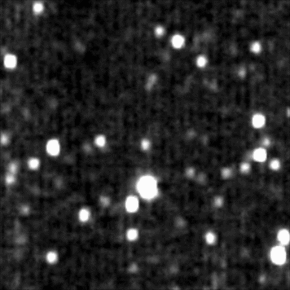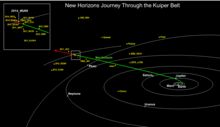15810 Arawn: Difference between revisions
Kwamikagami (talk | contribs) Undid revision 1077712317 by LouisTheFox1997 no RS |
→Orbit and physical properties: simplify |
||
| Line 43: | Line 43: | ||
Arawn is moving in a relatively eccentric orbit entirely beyond the orbit of [[Neptune]]. With a [[semi-major axis]] of 39.4 [[Astronomical unit|AU]], it orbits the Sun once every 247 years and 6 months (90,409 days). Its orbit has [[perihelion]] (closest approach to the Sun) of 34.7 AU, an [[aphelion]] (farthest distance from the Sun) of 44.1 AU, an [[orbital eccentricity|eccentricity]] of 0.12 and an [[orbital inclination|inclination]] of 4[[Degree (angle)|°]] with respect to the [[ecliptic]].<ref name="jpldata" /> It is a [[plutino]], being trapped in a 2:3 [[resonance|mean motion resonance]] with Neptune, similarly to dwarf planet [[Pluto]], the largest known plutino. |
Arawn is moving in a relatively eccentric orbit entirely beyond the orbit of [[Neptune]]. With a [[semi-major axis]] of 39.4 [[Astronomical unit|AU]], it orbits the Sun once every 247 years and 6 months (90,409 days). Its orbit has [[perihelion]] (closest approach to the Sun) of 34.7 AU, an [[aphelion]] (farthest distance from the Sun) of 44.1 AU, an [[orbital eccentricity|eccentricity]] of 0.12 and an [[orbital inclination|inclination]] of 4[[Degree (angle)|°]] with respect to the [[ecliptic]].<ref name="jpldata" /> It is a [[plutino]], being trapped in a 2:3 [[resonance|mean motion resonance]] with Neptune, similarly to dwarf planet [[Pluto]], the largest known plutino. |
||
It measures approximately {{convert|133|km|mi|abbr=on}} in diameter,<ref name="tnolist" /> based on an absolute [[Magnitude (astronomy)|magnitude]] of 7.6, and estimated albedo of 0.1.{{citation needed|date=August 2016}} Observations by the [[Hubble Space Telescope]] show that Arawn has a very red surface.<ref name="scinews-KBOs">{{Cite news|url=http://www.sci-news.com/space/color-kuiper-belt-objects-04290.html|title=Scientists Determine Color of Kuiper Belt Objects JR1 and MU69 {{!}} Planetary Science, Space Exploration|publisher=Sci-News.com|language=en-US|accessdate=2 November 2016}}</ref> In April 2016, |
It measures approximately {{convert|133|km|mi|abbr=on}} in diameter,<ref name="tnolist" /> based on an absolute [[Magnitude (astronomy)|magnitude]] of 7.6, and estimated albedo of 0.1.{{citation needed|date=August 2016}} Observations by the [[Hubble Space Telescope]] show that Arawn has a very red surface.<ref name="scinews-KBOs">{{Cite news|url=http://www.sci-news.com/space/color-kuiper-belt-objects-04290.html|title=Scientists Determine Color of Kuiper Belt Objects JR1 and MU69 {{!}} Planetary Science, Space Exploration|publisher=Sci-News.com|language=en-US|accessdate=2 November 2016}}</ref> In April 2016, its [[rotation period]] of 5.47 hours was determined.<ref name="NASA-Post-Pluto" /> |
||
== Quasi-satellite dynamical state and orbital evolution == |
== Quasi-satellite dynamical state and orbital evolution == |
||
Revision as of 03:52, 10 May 2022
 A distant view of Arawn (center) from New Horizons in November 2015.[n 1] | |
| Discovery[1] | |
|---|---|
| Discovered by | M. J. Irwin A. Żytkow |
| Discovery site | La Palma Obs. |
| Discovery date | 12 May 1994 |
| Designations | |
| (15810) Arawn | |
| Pronunciation | /ˈɑːraʊn/[2] |
Named after | Arawn (Welsh mythology)[1] |
| 1994 JR1 | |
| TNO · plutino[3][4] | |
| Orbital characteristics[5] | |
| Epoch 16 February 2017 (JD 2457800.5) | |
| Uncertainty parameter 2 | |
| Observation arc | 21.91 yr (8,002 days) |
| Aphelion | 44.241 AU |
| Perihelion | 34.720 AU |
| 39.480 AU | |
| Eccentricity | 0.1206 |
| 248.07 yr (90,609 days) | |
| 30.638° | |
| 0° 0m 14.4s / day | |
| Inclination | 3.8074° |
| 144.69° | |
| 101.89° | |
| Physical characteristics | |
| Dimensions | 133 km (83 mi)[6] 145 km (90 mi)[7] |
| 5.47±0.33 h[8] | |
| 0.04[8] | |
| 7.6[5] | |
15810 Arawn, provisional designation 1994 JR1, is a trans-Neptunian object (TNO) from the inner regions of the Kuiper belt, approximately 133 kilometres (83 mi) in diameter. It belongs to the plutinos, the largest class of resonant TNOs. It was named after Arawn, the ruler of the Celtic underworld, and discovered on 12 May 1994, by astronomers Michael Irwin and Anna Żytkow with the 2.5-metre Isaac Newton Telescope at Roque de los Muchachos Observatory in the Canary Islands, Spain.[1]
Arawn is unique in that it has been observed at a much closer distance than most Kuiper belt objects, by the New Horizons spacecraft, which imaged it from a distance of 111 million km (69 million mi; 0.74 AU) in April 2016; this and its other observations have allowed its rotation period to be determined.[7][9]
Orbit and physical properties
Arawn is moving in a relatively eccentric orbit entirely beyond the orbit of Neptune. With a semi-major axis of 39.4 AU, it orbits the Sun once every 247 years and 6 months (90,409 days). Its orbit has perihelion (closest approach to the Sun) of 34.7 AU, an aphelion (farthest distance from the Sun) of 44.1 AU, an eccentricity of 0.12 and an inclination of 4° with respect to the ecliptic.[5] It is a plutino, being trapped in a 2:3 mean motion resonance with Neptune, similarly to dwarf planet Pluto, the largest known plutino.
It measures approximately 133 km (83 mi) in diameter,[6] based on an absolute magnitude of 7.6, and estimated albedo of 0.1.[citation needed] Observations by the Hubble Space Telescope show that Arawn has a very red surface.[10] In April 2016, its rotation period of 5.47 hours was determined.[9]
Quasi-satellite dynamical state and orbital evolution
In 2012 Arawn was hypothesized to be in a quasi-satellite loop around Pluto, as part of a recurring pattern, becoming a Plutonian quasi-satellite every 2 Myr and remaining in that phase for nearly 350,000 years.[11][12] Measurements made by the New Horizons probe in 2015 made it possible to calculate the motion of Arawn much more accurately.[8] These calculations confirm the general dynamics described in the hypotheses.[13] However, it is not agreed upon among astronomers whether Arawn should be classified as a quasi-satellite of Pluto based on this motion, since its orbit is primarily controlled by Neptune with only occasional smaller perturbations caused by Pluto.[8][9][13]
Origin
Arawn is moving in a very stable orbit, likely as stable as Pluto's. This suggests that it might be a primordial plutino formed around the same time Pluto itself and Charon came into existence. It is unlikely to be relatively recent debris originated in collisions within Pluto's system or a captured object.[11]
Observation


Arawn is currently relatively close to Pluto. In 2017 it was only 2.7 AU from Pluto.[14] Before 486958 Arrokoth was discovered in 2014, Arawn was the best known target for a flyby by the New Horizons spacecraft after its Pluto flyby in 2015.[15][16]
Arawn was one of the first objects targeted for distant observations by New Horizons, which were taken on 2 November 2015.[17] More observations were made in April 2016.[7]
On 2 November 2015 Arawn was imaged by the LORRI instrument aboard New Horizons, making it the closest observation of a Kuiper belt object other than the Pluto–Charon system by a factor of 15.[18]
Between 7–8 April 2016, New Horizons imaged Arawn from a new record distance of about 111 million kilometers, using the LORRI instrument. The new images allowed the science team at Southwest Research Institute (SwRI) in Boulder, Colorado, to further pinpoint the location of Arawn to within 1000 kilometers. The new data also made it possible for scientists to observe Arawn's rotation period, which was determined to be 5.47 hours.[9]
Orbit

See also
References
- ^ a b c "(15810) Arawn". IAU Minor Planet Center. Retrieved 17 January 2017.
- ^ Matthieu Boyd, trans., The Four Branches of The Mabinogi, Broadview Press, 2017
- ^ Marc W. Buie (14 October 2006). "Orbit Fit and Astrometric record for 15810". SwRI (Space Science Department). Retrieved 2 October 2008.
- ^ Brian G. Marsden (17 July 2008). "MPEC 2008-O05 : Distant Minor Planets (2008 Aug. 2.0 TT)". IAU Minor Planet Center. Retrieved 26 August 2016.
- ^ a b c "JPL Small-Body Database Browser: 15810 (1994 JR1)" (2016-04-08 last obs.). Jet Propulsion Laboratory. Retrieved 26 August 2016.
- ^ a b "List of Known Trans-Neptunian Objects". Johnston's Archive. Retrieved 26 August 2016.
- ^ a b c "Catalog Page for PIA20589".
- ^ a b c d Porter, Simon B.; et al. (2016). "The First High-phase Observations of a KBO: New Horizons Imaging of (15810) 1994 JR1 from the Kuiper Belt". The Astrophysical Journal Letters. 828 (2): L15. arXiv:1605.05376. Bibcode:2016ApJ...828L..15P. doi:10.3847/2041-8205/828/2/L15. S2CID 54507506.
{{cite journal}}: CS1 maint: unflagged free DOI (link) - ^ a b c d "New Horizons Collects First Science on a Post-Pluto Object". New Horizons. NASA/JHUAPL/SwRI. 17 May 2016. Retrieved 26 August 2016.
- ^ "Scientists Determine Color of Kuiper Belt Objects JR1 and MU69 | Planetary Science, Space Exploration". Sci-News.com. Retrieved 2 November 2016.
- ^ a b de la Fuente Marcos, C.; de la Fuente Marcos, R. (November 2012). "Plutino 15810 (1994 JR1), an accidental quasi-satellite of Pluto". Monthly Notices of the Royal Astronomical Society: Letters. 427 (1): L85–L89. arXiv:1209.3116. Bibcode:2012MNRAS.427L..85D. doi:10.1111/j.1745-3933.2012.01350.x. S2CID 118570875.
{{cite journal}}: CS1 maint: unflagged free DOI (link) - ^ "Pluto's fake moon". 24 September 2012. Archived from the original on 25 March 2015. Retrieved 24 September 2012.
- ^ a b de la Fuente Marcos, Carlos; de la Fuente Marcos, Raúl (2016). "The analemma criterion: accidental quasi-satellites are indeed true quasi-satellites". Monthly Notices of the Royal Astronomical Society. 462 (3): 3344–3349. arXiv:1607.06686. Bibcode:2016MNRAS.462.3344D. doi:10.1093/mnras/stw1833.
{{cite journal}}: CS1 maint: unflagged free DOI (link) - ^ "50000 Quaoar distance (AU) from Pluto". Archived from the original on 25 February 2012. Retrieved 18 December 2007.
- ^ Ted Stryk / Emily Lakdawalla (24 January 2011). "Ted Stryk: Report from the 2011 New Horizons Science Team Meeting". The Planetary Society Blog. Retrieved 25 January 2011.
- ^ "25 closer candidates". Retrieved 30 September 2012.
- ^ "A Distant Close-up: New Horizons' Camera Captures a Wandering Kuiper Belt Object". New Horizons. NASA/JHUAPL. 4 December 2015. Retrieved 5 December 2015.
- ^ "New Horizons' catches a wandering Kuiper Belt Object not far off". SpaceDaily. 7 December 2015.
Notes
- ^ This four-frame animation depicting Arawn was taken on 2 November 2015, by New Horizons, when the spacecraft was 270 million km (170 million mi) away. Arawn is the white dot, just left of center, moving from right to left.
External links
- Asteroid Lightcurve Database (LCDB), query form (info Archived 16 December 2017 at the Wayback Machine)
- Dictionary of Minor Planet Names, Google books
- Asteroids and comets rotation curves, CdR – Observatoire de Genève, Raoul Behrend
- Discovery Circumstances: Numbered Minor Planets (15001)-(20000) – Minor Planet Center
- 15810 Arawn at the JPL Small-Body Database

